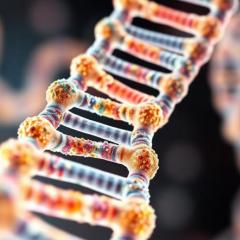The University of Queensland Diamantina Institute’s researchers have played a leading role in a recent study into osteoporosis, more than doubling the number of currently known genes in the disease.
Osteoporosis is a silent but frequent and devastating age-related disease: in Australia 25% of women with hip fracture die within 12 months, with an even higher mortality rate for men with hip fracture. Women older than 65 years are at greater risk for death after hip fracture than from breast cancer. While the consequences of osteoporosis are well established, the causes of the disease remain elusive. It has been known for a long time that osteoporosis is strongly genetically determined, but the responsible genes had remained largely unknown.
This situation has changed dramatically, due to the recent discoveries of UQDI researchers and their collaborators. In their study published in the leading genetic journal Nature Genetics, variants in 56 regions of the genome have been discovered to influence the Bone Mineral Density (BMD) of individuals. Fourteen of these variants were also found to increase the risk of fracture. This single study doubles the number of known genes for BMD, and is the first time such a large number of genetic variants have been found to be associated with fracture risk.
Bone mineral density measured by Dual Energy X-Ray absorptiometry (DXA) is the most widely used measurement to diagnose osteoporosis and to assess the risk of fracture. In general terms high BMD results in lower risk of fracture.
UQDI researchers Associate Professor Emma Duncan and Professor Matt Brown played leading roles in an international consortium of investigators from across Europe, North America, East Asia and Australia, bringing together more than 50 independent studies. Overall, the study involved more than 80,000 individuals with DXA scans to assess BMD; and more than 30,000 cases with fracture and 100,000 controls without fracture were studied in what constitutes the largest genetic study in osteoporosis performed to date.
“The Australian Osteoporosis Genetics Consortium played a key role in this recent paper,” said Associate Professor Emma Duncan. “Our own study, involving bone researchers from Australia, New Zealand and the United Kingdom, and supported by the National Health and Medical Research Council of Australia, was particularly important because of our unique approach of recruiting individuals with more extreme bone density. This meant that although we contributed a modest number of individuals to this current study, their impact was disproportionately powerful; and as a consequence the Australian contribution was the most powerful individual component of the entire project overall”.
Further, work by UQ’s Dr Dana Willner during her time at UQDI was responsible for identifying critical molecular pathways that are now candidates for therapeutic applications. Dr Fernando Rivadeneira, Assistant Professor of the Erasmus Medical Centre and lead senior author of the study adds, “Such potential is highlighted by the identification (among others) of genes encoding proteins that are currently subject to novel bone medications. Yet, even more interesting is the identification of several factors that can constitute targets for true bone-building drugs.”
This research leads to greater understanding of the biology of skeletal health and fracture susceptibility. “In addition to the known proteins and pathways we have identified we are also confronted with completely new biology”, says Karol Estrada, scientific researcher at Erasmus MC and first author of the publication. “There is, for example, very little known about the genomic region on chromosome 18 where we discovered the strongest genetic factor associated with fracture risk. Just less than a month ago the factor underlying the genetic signal was recognized as a gene, now known as FAM210A”.
“We also established that, as compared to women carrying the normal range of genetic factors, women with an excess of BMD-decreasing genetic variants had up to 56% higher risk of having osteoporosis and 60% increased risk for all-types of fractures”, adds Dr Douglas Kiel, Professor of Medicine at Harvard Medical School and the Institute for Aging Research at Hebrew SeniorLife in Boston, MA in the USA and senior author co-leading the study. “Even more interesting is our discovery of groups of individuals with a smaller number of variants which protected them against developing osteoporosis or sustaining fractures”.
The genome-wide association approach we will mean researchers can continue to identify hundreds of common variants underlying the risk of osteoporosis and fracture,” says André Uitterlinden, Professor of Complex Genetics at Erasmus MC. “Nevertheless, we will need new technologies and approaches to understand more”.
Professor Matthew Brown agrees, “Researchers at UQDI have been doing exactly this, by performing a whole-exome sequencing project in 1,000 individuals from our Australian Osteopororis Genetics Consortium. This further study, also supported by the NHMRC, will help us to understand the genetic underpinnings of this complex disease that is osteoporosis”.



